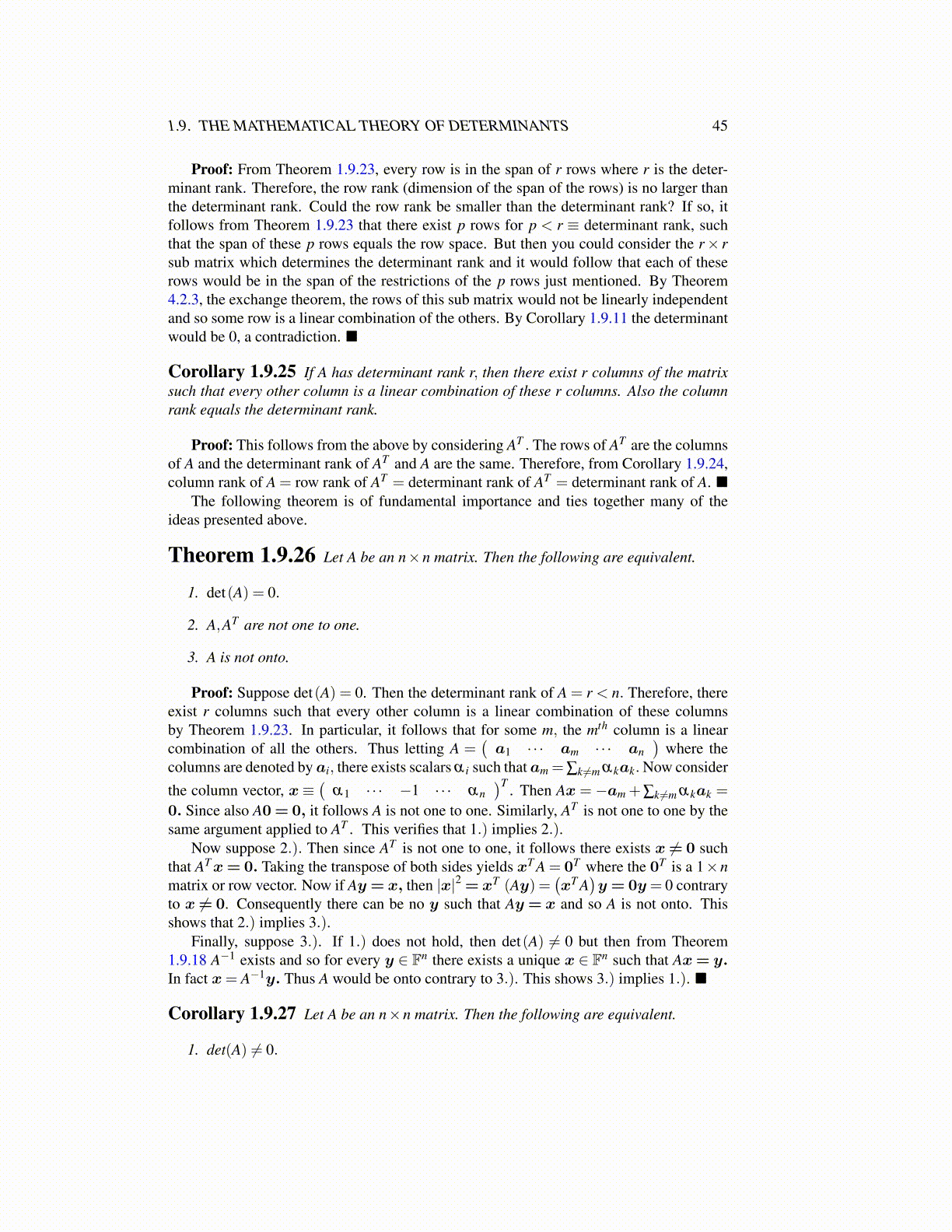
1.9. THE MATHEMATICAL THEORY OF DETERMINANTS 45
Proof: From Theorem 1.9.23, every row is in the span of r rows where r is the deter-minant rank. Therefore, the row rank (dimension of the span of the rows) is no larger thanthe determinant rank. Could the row rank be smaller than the determinant rank? If so, itfollows from Theorem 1.9.23 that there exist p rows for p < r ≡ determinant rank, suchthat the span of these p rows equals the row space. But then you could consider the r× rsub matrix which determines the determinant rank and it would follow that each of theserows would be in the span of the restrictions of the p rows just mentioned. By Theorem4.2.3, the exchange theorem, the rows of this sub matrix would not be linearly independentand so some row is a linear combination of the others. By Corollary 1.9.11 the determinantwould be 0, a contradiction. ■
Corollary 1.9.25 If A has determinant rank r, then there exist r columns of the matrixsuch that every other column is a linear combination of these r columns. Also the columnrank equals the determinant rank.
Proof: This follows from the above by considering AT . The rows of AT are the columnsof A and the determinant rank of AT and A are the same. Therefore, from Corollary 1.9.24,column rank of A = row rank of AT = determinant rank of AT = determinant rank of A. ■
The following theorem is of fundamental importance and ties together many of theideas presented above.
Theorem 1.9.26 Let A be an n×n matrix. Then the following are equivalent.
1. det(A) = 0.
2. A,AT are not one to one.
3. A is not onto.
Proof: Suppose det(A) = 0. Then the determinant rank of A = r < n. Therefore, thereexist r columns such that every other column is a linear combination of these columnsby Theorem 1.9.23. In particular, it follows that for some m, the mth column is a linearcombination of all the others. Thus letting A =
(a1 · · · am · · · an
)where the
columns are denoted by ai, there exists scalars α i such that am =∑k ̸=m αkak. Now considerthe column vector, x≡
(α1 · · · −1 · · · αn
)T . Then Ax = −am +∑k ̸=m αkak =
0. Since also A0 = 0, it follows A is not one to one. Similarly, AT is not one to one by thesame argument applied to AT . This verifies that 1.) implies 2.).
Now suppose 2.). Then since AT is not one to one, it follows there exists x ̸= 0 suchthat ATx= 0. Taking the transpose of both sides yields xT A = 0T where the 0T is a 1×nmatrix or row vector. Now if Ay = x, then |x|2 = xT (Ay) =
(xT A
)y = 0y = 0 contrary
to x ̸= 0. Consequently there can be no y such that Ay = x and so A is not onto. Thisshows that 2.) implies 3.).
Finally, suppose 3.). If 1.) does not hold, then det(A) ̸= 0 but then from Theorem1.9.18 A−1 exists and so for every y ∈ Fn there exists a unique x ∈ Fn such that Ax= y.In fact x= A−1y. Thus A would be onto contrary to 3.). This shows 3.) implies 1.). ■
Corollary 1.9.27 Let A be an n×n matrix. Then the following are equivalent.
1. det(A) ̸= 0.